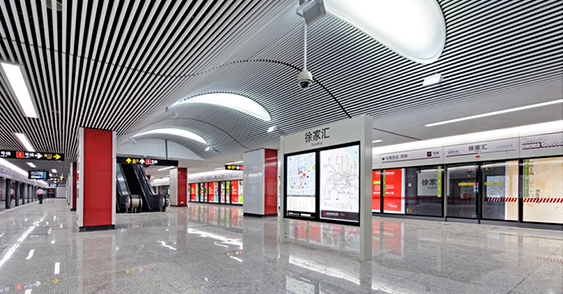
As the shields operate under the ground in the city center, it will inevitably affect the existing buildings and equipment. STEC has enormous experiences in ‘delicate operations’ in urban centers to meet the complex environment of urban rail transit rigor requirements like construction project risk, project’s quality, civilized construction and schedule control.
Tunnel of Shanghai Metro Line 11’s Xujiahui Station to Shanghai Stadium Station is located in Xuhui core business area, which is 1600 meters long in one way, passing through 23 heritage buildings like the Xuhui Middle School, and Xujiahui Catholic Church, and metro line 1 and 4 which are already in operation. Among which, five are super-grade heritage buildings, four are first-grade, four are second-grade and nine are third-grade historical buildings. The closest distance between the shield and Xujiahui Catholic Church is only 8 meters. Through a series of land subsidence control measures, we managed to keep the soil loss rate of the super-grade heritage buildings to 1.5 ‰ ~ 3 ‰, and the overall loss rate is controlled around 5 ‰ one month after the shield passing through. We make sure the safety of the building and subway deformation is also controlled. Meanwhile, thanks to good on-site management capabilities and innovative parties construction framework, we maintained a good relationship with the residents of the surrounding communities, facilities organizations, and shopping malls, alleviating any potential problems in the central business district.

Shanghai Outer Ring Tunnel is the key link crossing the Huangpu River as the northern part of Shanghai Outer Ring Road. It is also the first cross-river tunnel in Shanghai which is constructed by immersed tunneling method and is the largest scale in Asia. The immersed tunneling method was introduced to China in 1980s, so it marked the first time that STEC constructed immersed tunnel in such a big scale. The location of the construction is near the Yangtze River estuary. The tide variation brought high construction risk and difficulty. During the construction, STEC managed to sink enormous tabulation (9.55 meters high, 43 meters wide, 100 - 108 meters, weight of 45000 tons of each). We skillfully grasped the axis, elevation and mileage changes. We ensured that the construction quality reach the design precision under harsh conditions of high wind flow, ferocious back silting. By using satellite positioning system and 3D bathymetry technology, we overcame the water displacement difficulty of the pipe sinking construction and promoted immersed tunnel construction level in our country to an international advanced level.
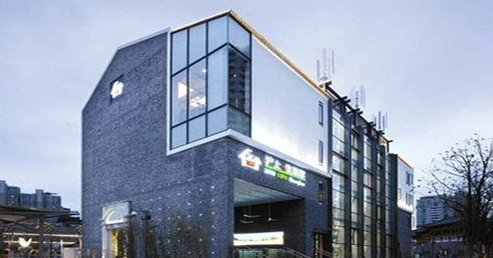
Concrete recycling technique utilizes large quantities of industrial and construction waste during concrete production, such as concrete aggregate, mechanism sand, steel slag powder, FGD gypsum and fly ash, to replace 30%-50% gravel, river sand and cement. Tongji University and STEC started to develop the technique since 2006. During 2010 World Expo, recycled concrete was applied to the Shanghai Eco House in the UBPA, in co-operation with Shanghai Research Institute of Building Sciences Group. This project ranked top in the domestic construction and was close to the international standard. The technique was given the Shanghai Resource Comprehensive Utilizing Prize in 2011, and Shanghai Science and Technology Progress Award in 2013. The application of the concrete recycling technique established a high-efficient method to deal with mass industrial and construction waste with low energy consumption. This helps the city turn the waste into precious mineral resources.
Currently, STEC sets its own recycling aggregate production line and construction waste consumption spot to deal with the waste on site in large demolishing projects, or collect and handle the waste together for small-and-medium demolishing projects. Through establishing a city construction waste information cloud platform, we strive to build an industry chain cycle, synthesize collecting of concrete waste, producing and processing recycling aggregate, and green recycling concrete as one application.

Shanghai Tower is China's first and the world's third tallest building, with 118 floors in the main building with a total height of 632 meters. As its supporting project - Shanghai Tower Gas Drainage Pipe Project reaches 121 floors directly through pipelines, once again recreating the world's highest gas supply record, over Shanghai Global Financial Center. We undertook the design of the internal pipelines and the alarm system of Shanghai Tower and its gas installation project. In terms of the design, we added the automatic alarm and automatic cutting system into the gas system, which could ensure the gas source could be cut timely and effectively once gas leakage occurs, and prevent fire and explosion accidents to ensure gas safety. In construction, 150mm-diameter seamless steel pipe needed to be installed from the underground fourth floor to the top of Shanghai Tower, with only the diameter length up to 600 meters. The height of the pipeline construction is unprecedented. In addition, the settlement of the construction itself also brings some difficulties to the relatively static installation of natural gas pipeline. As the project is carried out in super high-rise building, safety issues are the primary factor. Therefore, before construction, we successfully overcame difficulties such as the gas pipe installation work high above the ground and multiplication of pipe bearing pressure, by comprehensively analyzing gas source, pressure, safety and geography factors. By arranging the bearing support and the telescopic compensator at the bottom of each gas vertical tube in Shanghai Tower, the total 6-ton-weight vertical tube in 120 floors with the diameter of 500 meters was properly dissipated. This has effectively solved the high construction pipeline deformation problem and ensured transmission security of natural gas with 4,000 cubic meters per hour. The smooth implementation of this project can further improve STEC’s high-rise gas construction and management standards and provide a reliable reference point for similar projects in the future.

Shanghai-Jiading Expressway is the first expressway in China, linking Qilianshan Road in northwestern Shanghai in the South and South Jiading Gate in the north. The total length is 20.5 kilometers. Two interchanges, Nanxiang and Malu, were built along the expressway, which were designed, constructed and maintained by STEC. In terms of its linear design, we introduced perspective inspection method to check the expressway’s route planning and its plane/longitudinal linear displacement. Eventually the design team came up with a road planning solution that matches greatly with the expressway environment that significantly improved the driving experience. The two diamond-shaped interchange along the Shanghai-Jiading Expressway has proved to be a solution to less land utilization and lower project cost. The upper structure of the interchange is built with pretensioning cored slab beam, combined box beam and post-tensioning T beam. To reduce the numbers of expansion joints and improve the runway’s flatness and bridge utility, the bridge surface adopted simple supported beam system with continuous slabs on the top, while the substructure adopts pier foundation. During the construction, we successfully solved the problem of building structures on the soft soil with the aid of the new research finding “setting up embankments on soft soil foundation” In addition, our findings of “fly ash as the filling material of expressway embankments” was given the 1st prize of Shanghai Science and Technology Progress Award and “simulations on expressway traffic system monitoring” was awarded the 2nd prize. In 2014, STEC finished the renovation of Shanghai-Jiading Expressway. This “phoenix nirvana” will surely bring new life to the expressway and grant users a more comfortable driving experience. The completion of Shanghai-Jiading Expressway marks the history of China’s first expressway.
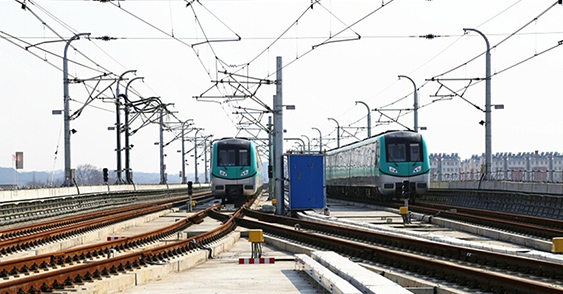
STEC invested 13.45 billion yuan in constructing the first phase of the Jiangsu Nanjing Metro Line S1 Project (The Airport Line), which was carried out in the form of total integration. The airport line links Lukou International Airport in the south and Nanjing South Railway Station, which provided the most extensive coverage with the most complete investment and financing model in China.
As the earliest company to start the construction of urban rail transit system in the industry, we have professional knowledge and rich experience in rail financing, investing, designing, planning,civil engineering, mechanical electronics, operating and maintaining. During the construction of Nanjing Airport line, our professional construction team adopted several advanced construction technologies such as GPST and URUP. Guided by principles of strict quality control and construction safety, we cooperated with the best quality suppliers like China Railway Express and Hongrun, to develop a high-quality project. Thanks to our good credit resources, we incurred less financing cost to bring in Shanghai financial institutions. In order not to monopolize the local bank resources and loan amount, we extended the project financing period to 25 years, which greatly reduced the pressure on the local government to pay the money back. This also provides our client a one-stop service with the highest quality and lowest cost rail transit system.

Qianjiang Channel is constructed by STEC through BOT investment with 3.884 billion yuan. It is China's first large diameter shield tunnel project, integrating "investment, construction, operation and maintenance”.
In terms of investment and financing, STEC determined the financial services program and partners through bank bidding for the first time. By cooperating with the Bank of China, China Merchants Bank and Shanghai Pudong Development Bank, STEC raised comprehensive credit of 25.4 billion yuan in total, effectively reducing the overall cost of financing, distributing the pressure of funds from tight monetary policy to different banks. We avoided capital risk and ensured the capital is secured.
In terms of the construction, we successfully pushed 15.43 meters’ diameter large shield machine crossing the embankment foundation of the Ming Dynasty Qianjiang Levee for 4 times, overcoming the world-class difficulty to build express way tunnel in the special hydrological conditions of Qiantang River. In addition, Qianjiang Channel is the first batch of model construction project subsidized by the national budget from the central government which funds semiconductor lighting products application. The whole tunnel was equipped with LED light source illumination. It can save 2.47 million kwh each year compared to ordinary fluorescent lamp system. After the opening of the tunnel, STEC, as its operation and maintenance agent has formulated safety regulations, management system, and operation manual for the tunnel, thereby establishing a management system fitting for local project operation.

Desulfurization gypsum plaster mortar consists of mineral admixture, gypsum, glass beads, fine aggregate, water retaining agent, retarder, and other additives. It’s powder material mixed in a factory in certain proportion. The product has a good anti-crack protection effect, high cohesional strength, and good water retention. The product meets the Shanghai local standard of "Desulfurization Gypsum Plastering Mortar Application Regulations”. It’s the ideal and new green environmental-protection material for building’s interior wall leveling treatment, which can ensure a smooth wall, and prevent the wall from cracking and hollowing. The product has been successfully applied to the Pujiang Ruihe City Project, and Vanke Projects in Shanghai, Jiaxing, Ningbo, Suzhou, Wuxi, and Xuzhou. The construction area reached millions of square meters. The project was ratified by most clients, owners and contractors.
At present, we have a gypsum plaster mortar professional construction team of more than 650 people, equipped with professional construction management, quality management, safety management, and also 32 sets of German imported pulp shooting machines, which can fulfill the requirements of 8 to 10 large projects at the same time.
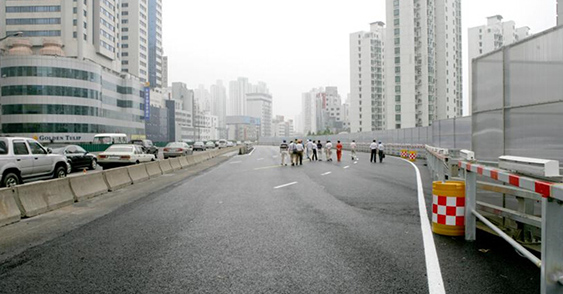
Shanghai Inner Ring Road, also known as Shanghai Inner Ring, is the earliest elevated highway constructed in the city, and has a nickname of “Shanghai’s First Ring”. Stretching 47.7 meters, the highway consists of 49 continuous transition curves and straight lines, linking Pudong and Puxi through Nanpu Bridge and Yangpu Bridge. It functions as a protective shell for the city center traffic. The segment of Puxi and Pudong opened to the pubic in 1994 and 2009 separately. The highway has four lanes in both directions, with a speed limit at 80 km/h. Since the construction of the Inner Ring Road, STEC took charge of constructing, designing, renovating the Inner Ring Road and maintaining its Puxi segment. In 1993, STEC took on the task of the first-stage construction and co-designing work of the Inner Ring Road, which was” Shanghai municipal No.1 project”. For the second-stage, we were in charge of the construction and design of the southwestern segment. In terms of the design, we carried out a research with Tongji University about how Shanghai Inner Ring Road’s southwestern segment connect the main roads. The research results significantly impacted the layout of the entire ring road and created lots of new ideas and successful experiences for the later construction of the large interchange in city center. In the new century, we have undertaken the work of designing and renovating the Inner Ring Road’s Pudong segment. Finally, all of the Inner Ring Road was open to the public. We also participated in renovating the ring road, and paving the asphalt layer to welcome the Expo. We also changed the 29 km of street lamps along the Inner Ring Road in Puxi segment. The new street lamps used the LED energy-saving light, with low power consumption, high lighting efficiency, and long service life. The energy-saving efficiency is up to 50%. The light can also withstand Beaufort wind scale. On top of which we created an integrated portable working device with anti wall-bumping. The device looks like a box, in which workers can construct. It can sharply reduce the noise. The innovation also won a national patent. The 2A, first phase of Shanghai Inner Ring Road project constructed by STEC was given the Shanghai Magnolia Quality Project Award in 1993.
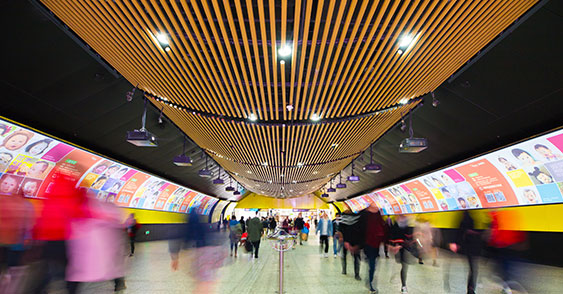
As the first urban rail transport construction company, STEC began the experimental project of Shanghai Metro Line 1 since 1966. In 1980, we undertook the test project of Shanghai Metro Line 1 expansion. We also completed the metro shield tunneling and tunnel lining structure selection, developed the high-precision reinforced concrete (RC) segments technology, underground diaphragm walls construction techniques, and a deep excavation technology, which were widely used in Shanghai Metro line 1 and line 2 projects later, thus reinforcing our leading position in tunnel and rail transport industries. Shanghai Metro Line 1 is a modern fast track running from north to south, across the city center. STEC constructed Line 1’s 10 stations, and 10 intervals, including Shanghai Railway Station, Caobao Rd Station, Shanghai Stadium Station, and the interval from Shanghai Stadium station to Xujiahui station, People's Square Station to Huangpi Rd Station. During the construction of Line 1, we introduced two 6.34 m diameter earth pressure balance shield manufactured by French FCB for drive-in, and also used a belt conveyor dump system for the first time.

A city’s culture and footprints lie in its history. STEC dedicates itself to providing more continual construction blueprints for the city; in ensuring the project’s smooth development, STEC will perpetuate the city culture and protect the cultural environment.
The Shanghai Bund Tunnel is known as the major project in solving the transportation problems in city center. It extends 3.3 kilometers in total length. STEC needs to first guarantee the transportation system in the Bund and the stability of the surrounding erections; then we try to push 14.27-meter diameter long earth pressure balance shield crossing the historic architecture groups along the Bund with precision. Since most of these buildings are over hundred years, there exists uneven degrees of subsidence, leaning and structure aging, which indicates that large-scale shield method for them is a major operation.
During the whole construction, STEC views the protection of historic constructions as the first priority; “FCEC shelter pile and slip casting reinforcement” protection method has been established after several negotiations and experiments on site. Finally, FECE shelter pie technology which takes more working periods is applied to crossing the Astor House Hotel, the minor distance of which is only 1.7 meters. As for other regions, specialized slip casting reinforcement technology is put into use. After the whole project, the subsidence of historic constructions is merely 5.3 millimeters at most and the upheaval of which is just 3.7 millimeters at most, which are far lower than the expected control index.
It is STEC’s advanced construction skills that bring about more options for the exploitation of underground space in city core areas and the improvement of city transportation. Just like the stable, secure and convenient projects we have completed in suburban areas, we can also successfully construct tunnel projects in the prosperous city center.
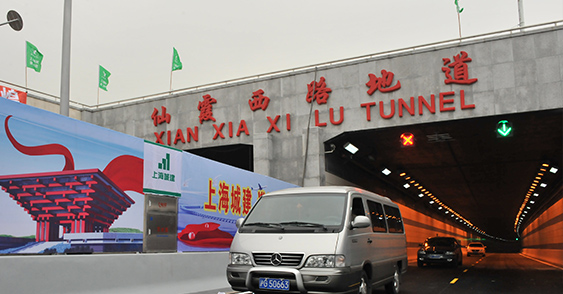
Shanghai West Xianxia Road Construction Project, located in Hongqiao Integrated Transport Hub, is not only an important part of the road construction work of Hongqiao Integrated Transport Hub but also the biggest single project in Hongqiao municipal supporting project. The total length of the road is 3.06 kilometers. The construction should pass through some affiliated parts of the airport, such as two taxiways in east and west, runway blast pads, runway signal lamp strip. As such, the requirement of the project is very demanding as it has to meet the ground deformation level of the airport. Through the upgrading and innovation in techniques and facilities, we have set a precedence for large slurry shields to cross under shallow soil of the airport runway, which is also the first underpass through the working airport runway in China. We have tackled the key problems by conducting a research “The Key Technology For Slurry Shield with Big Diameter to Pass under Shallow Soil of Airport Runway.” during the construction. We managed a series of innovative results, and won three patents, two software copyrights and a construction technology certification. The project was also given the 1st Prize of Shanghai Science and Technology Progress Award. In addition, the project was honored with several awards, including the 1st prize of National Quality Construction Project, the 3rd prize of National Outstanding Project, and the golden award of Shanghai Municipal Projects. The completion of West Xianxia road successfully optimized and improved the functions and layout of Hongqiao Integrated Transport Hub, coordinated and boosted the regional development and improved the transportation system.